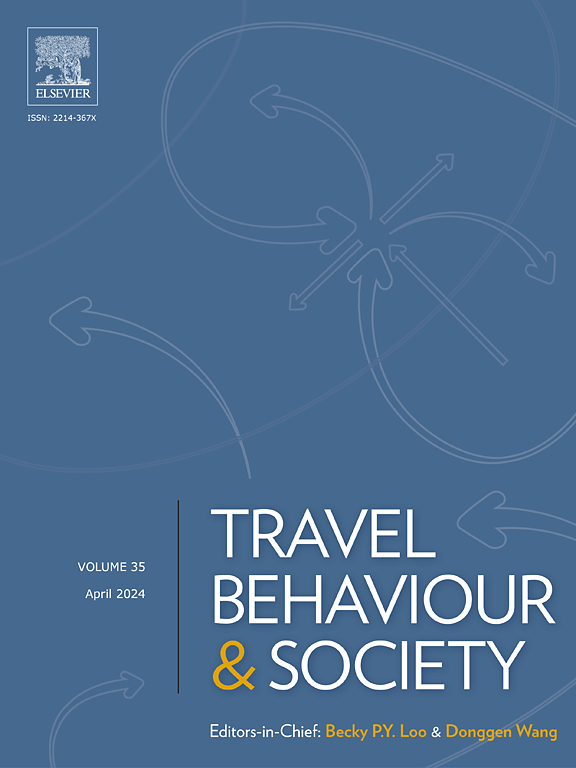Free interchange for better transit? Assessing the multi-dimensional impacts on metro to bus interchange behavior − insights from an explainable machine learning method
IF 5.1
2区 工程技术
Q1 TRANSPORTATION
引用次数: 0
Abstract
This study investigates the impact of a newly implemented public transport interchange discount policy in Suzhou, China, focusing on its effects on metro-to-bus interchange behaviors across various spatial and temporal dimensions. Utilizing two distinct datasets spanning periods before and after the policy’s implementation, a comprehensive spatial–temporal analysis was conducted, covering weekdays, weekends, and holidays. A novel, real-time, distance-weighted methodology was developed to more accurately identify metro-to-bus interchange catchments, thereby refining the modeling scope. The study examines the interplay between land use, socio-demographic factors, and bus-related attributes—including a newly proposed operation-opportunity combined bus accessibility metric—using an explainable machine learning approach. Results indicate that the interchange discount policy has had an overall positive, though varied, impact on interchange behaviors, with the most pronounced effects observed during weekdays in central urban areas and at metro line bends. Specifically, 76.1 % of metro stations saw an increase in metro-to-bus interchange ratios on weekdays following the policy’s implementation, with increases observed at 66.4 % and 67.3 % of stations during weekends and holidays, respectively. Overall, the interchange ratio increased by 12.49 %, with a 17.45 % increase on weekdays. The analysis also reveals that factors such as bus accessibility, bus-to-bus interchange, and population density exhibit different effects depending on the time of week, with non-linear patterns emerging. The policy’s introduction shifted the impact thresholds for certain factors, initially triggering competition between bus and metro services but eventually leading to a synergistic rise in metro-to-bus transfers as bus-to-bus interchange ratios increased. Additionally, the policy altered the significance of population density, enhancing the attractiveness of multimodal interchange for users who previously favored other modes of transport.
免费换乘带来更好的交通?评估地铁与公交换乘行为的多维影响--来自可解释机器学习方法的启示
本研究调查了中国苏州新实施的公共交通换乘折扣政策的影响,重点关注该政策在不同时空维度上对地铁与公交换乘行为的影响。利用政策实施前后的两个不同数据集,进行了全面的时空分析,涵盖了工作日、周末和节假日。研究还开发了一种新颖的实时距离加权方法,以更准确地确定地铁到公交换乘站的覆盖范围,从而完善建模范围。研究采用可解释的机器学习方法,检验了土地利用、社会人口因素和公交车相关属性之间的相互作用,包括新提出的运营-机会相结合的公交车可达性指标。结果表明,换乘折扣政策总体上对换乘行为产生了积极影响,但影响程度不一,其中在工作日的中心城区和地铁线路拐弯处观察到的影响最为明显。具体而言,在政策实施后,76.1% 的地铁站在工作日的地铁与公交换乘率有所上升,在周末和节假日,分别有 66.4% 和 67.3% 的地铁站的换乘率有所上升。总体而言,换乘率增加了 12.49%,其中工作日增加了 17.45%。分析还显示,公交可达性、公交换乘和人口密度等因素在不同的时间段会产生不同的影响,出现非线性模式。该政策的出台改变了某些因素的影响阈值,最初引发了公共汽车和地铁服务之间的竞争,但随着公共汽车与公共汽车换乘率的增加,最终导致了地铁与公共汽车换乘率的协同上升。此外,该政策还改变了人口密度的重要性,增强了多式联运换乘对以前偏爱其他交通方式的用户的吸引力。
本文章由计算机程序翻译,如有差异,请以英文原文为准。
求助全文
约1分钟内获得全文
求助全文
来源期刊

Travel Behaviour and Society
TRANSPORTATION-
CiteScore
9.80
自引率
7.70%
发文量
109
期刊介绍:
Travel Behaviour and Society is an interdisciplinary journal publishing high-quality original papers which report leading edge research in theories, methodologies and applications concerning transportation issues and challenges which involve the social and spatial dimensions. In particular, it provides a discussion forum for major research in travel behaviour, transportation infrastructure, transportation and environmental issues, mobility and social sustainability, transportation geographic information systems (TGIS), transportation and quality of life, transportation data collection and analysis, etc.
 求助内容:
求助内容: 应助结果提醒方式:
应助结果提醒方式:


